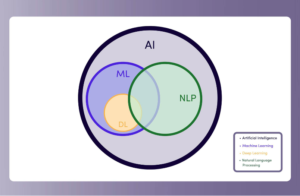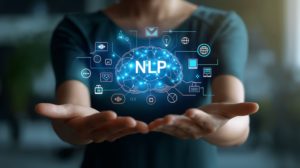Anyone who has ever tried to learn a new language knows how complex it is. Grammar, syntax, and vocabulary are just the starting points. Real fluency involves tone, context, and subtle cues that influence meaning.
Now, imagine teaching that to a machine.
Every day, businesses generate and process vast amounts of written and spoken communication—emails, support tickets, customer reviews, meeting transcripts, social media posts. Much of this data is unstructured, making it difficult to analyze using traditional methods. This is where Natural Language Processing (NLP) steps in, helping machines move beyond simple keyword detection to understanding the real meaning behind words and phrases.
The result? Businesses can automate workflows, improve customer interactions, detect fraud, and uncover insights hidden in text. In this blog, we’ll explore how NLP works, its practical business applications, and the challenges that come with teaching machines to understand human language.
What is Natural Language Processing (NLP)?
At its core, Natural Language Processing (NLP) is a field of artificial intelligence that enables computers to process and interpret human language. Unlike structured data (like numbers in a spreadsheet), human language is messy—full of idioms, multiple meanings, and cultural nuances that machines struggle to grasp.
NLP helps bridge this gap by enabling machines to:
– Recognize speech and text
– Understand meaning and sentiment
– Translate languages
– Generate human-like responses
Consider these two sentences:
– “My husband is French.”
– “Excuse my French.”
Both contain the word French, yet they mean completely different things. A computer trained on literal meanings would struggle to differentiate between the two. NLP techniques help machines learn context, making them more effective at interpreting language in real-world applications.

How Businesses Are Using NLP Today
Businesses are integrating NLP into their operations in powerful ways. Here are some of the most impactful use cases:
1. Automating Customer Support
No one likes waiting on hold. NLP-powered chatbots and virtual assistants allow businesses to handle customer inquiries instantly, reducing response times and improving satisfaction. These bots don’t just provide scripted answers—they can analyze customer sentiment and adapt their responses accordingly.
Example: A telecom company’s chatbot can diagnose internet issues based on customer complaints and suggest troubleshooting steps.
2. Extracting Insights from Customer Feedback
Every day, businesses receive valuable feedback through reviews, surveys, and social media. NLP can sift through this data to identify trends, uncover pain points, and track customer sentiment over time.
Example: An airline might analyze Twitter mentions to detect spikes in complaints about delayed flights, allowing them to respond proactively.
3. Enhancing Search and Information Retrieval
Internal business search engines powered by NLP allow employees to find relevant documents quickly—without needing to remember exact filenames or keywords.
Example: A law firm can use NLP to scan thousands of legal documents and find case precedents based on contextual meaning rather than specific keywords.
4. Fraud Detection and Cybersecurity
Phishing emails and online scams rely on deceptive language. NLP can analyze incoming messages and detect patterns that indicate fraudulent activity, helping businesses protect themselves from cyber threats.
Example: Banks use NLP to flag suspicious customer transactions or scam emails that contain subtle warning signs.
5. Automating Data Entry and Document Processing
Businesses spend countless hours processing contracts, invoices, and compliance documents. NLP can extract relevant details automatically, reducing manual effort and human error.
Example: A healthcare provider can use NLP to digitize handwritten doctor’s notes and extract key medical information.

The Challenges of NLP in Business Applications
Despite its advantages, NLP is far from perfect. Human language is full of complexities that make machine interpretation difficult. Some of the biggest challenges include:
1. Language Ambiguity
Words can have multiple meanings depending on context. Even sophisticated NLP models sometimes struggle with homonyms, sarcasm, and cultural references.
Example: “That was a sick performance.”
Does sick mean excellent or does it refer to illness?
2. Data Preprocessing is Crucial
Before a machine can understand text, it must be cleaned and structured. This includes:
– Removing unnecessary characters (punctuation, emojis)
– Standardizing formats (converting all text to lowercase)
– Eliminating stop words (e.g., the, and, is)
– Identifying the root form of words (e.g., running -> run)
3. Handling Multiple Languages and Dialects
With over 6,500 languages spoken worldwide, NLP must be trained on multiple linguistic patterns. Slang, regional dialects, and industry jargon add further complexity.
4. Understanding Tone and Emotion
Sarcasm, irony, and subtle emotional cues are hard to detect for machines. Sentiment analysis tools are improving, but misinterpretation is still a challenge.
Example: “Oh great, another meeting.”
A literal interpretation might classify this as positive, but humans recognize the sarcasm.
5. Privacy and Security Concerns
Businesses using NLP must ensure compliance with data privacy laws. Processing customer conversations or medical records requires careful handling of sensitive information.
How NLP Works: Breaking Down the Process
NLP is not a single algorithm, but a combination of multiple techniques used together to make sense of language. Here’s a deeper breakdown of key NLP processes:
- Tokenization: The process of splitting text into individual words or phrases (tokens). This is the first step in language processing, making it easier to analyze and manipulate text.
- Part-of-Speech (POS) Tagging: Assigning labels to words based on their role in a sentence (noun, verb, adjective, etc.), which helps computers understand grammatical structure.
- Named Entity Recognition (NER): Identifying and categorizing key entities in text, such as people’s names, dates, locations, and company names. This is particularly useful in legal and financial document analysis.
- Parsing: Analyzing the grammatical structure of a sentence to determine relationships between words. This helps in understanding complex sentence constructions.
- Sentiment Analysis: Detecting emotions in text—whether the content expresses positive, negative, or neutral sentiment. Businesses use this to gauge customer satisfaction from reviews and social media comments.
- Text Summarization: Extracting key points from long pieces of content to generate concise summaries, useful for news articles, reports, and customer feedback analysis.
Each of these steps builds upon the previous one, adding layers of meaning and making NLP more precise in real-world applications.
The Future of NLP in Business
As NLP technology advances, businesses will gain even more powerful tools for processing language. Here’s what the future might hold:
1. AI-Powered Content Creation
Tools like GPT can already generate news articles, marketing copy, and even legal documents. Expect businesses to rely more on NLP for automated content generation.
2. Real-Time Translation and Global Expansion
NLP-powered translation tools will allow businesses to communicate seamlessly across languages, making international expansion easier.
3. Smarter Virtual Assistants
Future chatbots will move beyond pre-programmed responses, engaging in more human-like conversations that understand context and intent.
4. Personalized Customer Interactions
NLP-driven analytics will allow businesses to tailor customer interactions based on past behaviors and preferences.

NLP and the Future of Business
Natural Language Processing is transforming the way businesses interact with data, customers, and internal operations. From automating customer support to detecting fraud and improving decision-making, NLP is no longer just a futuristic concept—it’s a practical tool that’s reshaping businesses today.
However, NLP still faces hurdles. Language complexity, data privacy concerns, and contextual understanding remain challenges that require constant refinement. As technology evolves, businesses that leverage NLP effectively will gain a significant competitive edge in an increasingly data-driven world.
